How to prepare surfaces for painting in commercial buildings
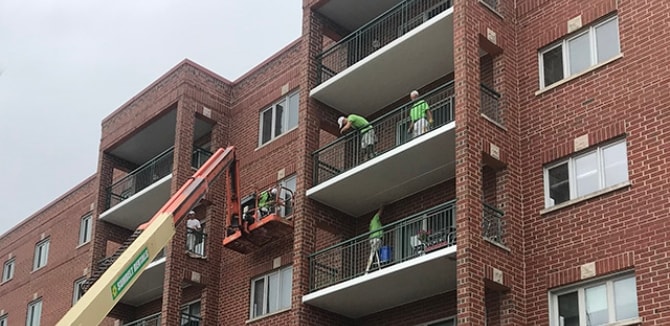
There is plenty of value to be found in painting a commercial building, but the most successful painting projects involve plenty of planning for preparing surfaces for painting. Most commercial property owners define success as a project that is finished on time, on budget with outcomes that look professional and last a long time. When you partner with a high-quality, trusted and proven commercial painting contractor, you will have successful outcomes with your project.
The best painting contractors for commercial buildings provide all the services you need, which means you don’t have to bring in multiple contractors to complete the job. For example, your contractor should provide surface preparation for painting services, which includes pressure washing, caulking and other tasks that get the surfaces 100 percent ready for paint.
By following our lead, you can rest assured that you’re bringing the right contractor to the project.
Check out the following to figure out which is best for you:
- What is painting preparation work?
- Why prep work for commercial painting is so important
- How to prepare a commercial building for interior and exterior painting
- Interior painting preparation
- Exterior painting preparation
- How professional painting contractors prepare walls for painting
- How to prepare concrete surfaces for painting
- How to prepare metal surfaces for painting
- How to prepare wood surfaces for painting
What is painting preparation work?
Painting preparation is all the work that is done prior to painting. This can include cleaning, sanding, fixing surfaces that are damaged and using primer. In order for paint to adhere properly to a surface, it needs to be prepped, which could include everything from washing it to filling gaps to sanding surfaces down and ensuring all debris is clear from the surfaces that will be painted.
Taking these steps not only provides better adhesion, it also makes the surfaces more aesthetically appealing once they’re painted. When the prep phase is rushed, the outcomes will be far from appealing.
Why prep work for commercial painting is so important
The best painting contractors know that there are multiple factors that impact the outcome of a painting project. Temperature, humidity levels, airflow, the quality of the paint and the quality of the equipment used to apply it all matter, but none of it will have a quality outcome if there isn’t proper prep work for painting first.
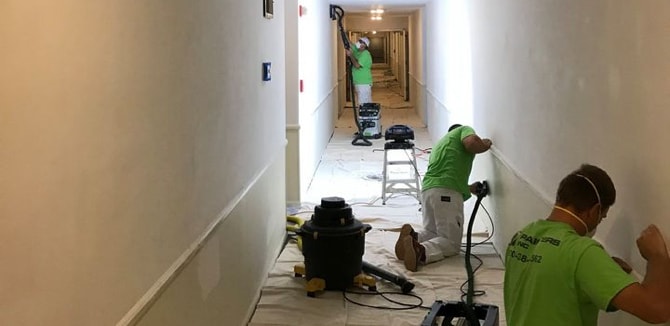
If you see a commercial building with a stunning paint job, you can be sure there was plenty of preparation work that went in before a paint brush ever touched the surface. Again, you can use the most expensive and highest-rated paint, but it will be essentially worthless on a surface that hasn’t been prepped. For example, if the surface is dirty, the paint might look okay for a while, but because paint won’t properly adhere to a dirty surface, it will soon begin to crack, peel or bubble.
When you’ve got bubbling paint on your commercial property, it doesn’t say many good things about your brand and your curb appeal will take a nosedive. And while that’s a fairly substantial negative, you also have to consider the time and money that you’ve wasted because the crucial preparation phase wasn’t taken seriously.
When you bring in the right painting contractor, you can rest assured that the preparation phase in your commercial painting project will not be ignored.
How to prepare a commercial building for interior and exterior painting
Knowing how to prep for exterior painting is the hallmark of a quality contractor, as is knowing how to prep for interior painting. Without this knowledge, there is no way a contractor can succeed. Not only do they know the tricks of the trade, they spend ample time on the preparation phase, making deliberate efforts to ensure every surface is 100 percent ready for paint.
Interior painting preparation
Interior painting preparation is required for any interior job if it is going to have a chance at meeting the expectations of the customer. One thing that can’t be denied about the best painting contractors out there – they are customer-centric and do everything possible to please them. That’s why they take preparing interior walls for painting so seriously.
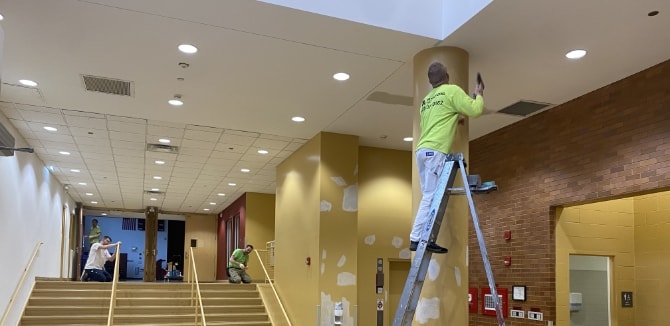
Commercial clients are often among the most demanding, as there is a lot of responsibility placed on project leaders and building managers to satisfy leadership, as well as provide a quality workspace for all the employees. That’s why there is so much value placed on choosing the right painting contractor. To avoid getting into a less-than-perfect situation, choose a contractor that makes substantial efforts in repairing the interior walls for painting.
Obviously, the top contractors know how to prepare surfaces for painting, as they have team members with experience in evening surfaces, repairing cracks and blemishes or doing some light carpentry or masonry work on areas that require more attention. But they also prepare the interiors by removing electronics, moving and/or covering furniture, protecting soft furnishings and other tasks that fully prepare all areas of the workspace.
Exterior painting preparation
The best exterior painting projects begin with preparing exterior walls for painting. Hire the right exterior painting contractor and you will have all your surfaces fully readied for paint. This includes a variety of exterior painting preparation services, such as pressure washing walls so all the dirt, grime and debris are cleared. It also includes removing old caulking and putting in new caulking, removing loose paint and making repairs to cracks and other damages.
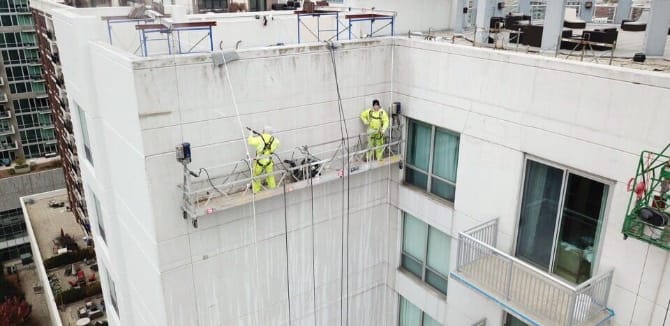
Commercial building exterior painting projects require a contractor committed to excellence in every aspect, from planning to preparing for exterior painting to bringing in the right tools/equipment for the job. The exteriors of commercial properties can range in their surface makeup, sometimes in one job, which is why your contractor needs to have experience preparing all types of exterior surfaces, not just some of the more common ones.
Prep for exterior painting most often includes washing the surfaces, which could involve everything from a power washer (only on durable surfaces) to wiping down surfaces, either with a detergent or water alone. Quality contractors will ensure all surfaces are completely clean and dry before applying paint, as moisture and debris will prevent the paint from properly adhering.
How professional painting contractors prepare walls for painting
Quality painting contractors know how to prep walls for painting and that each job will be different and require a customized approach. Some will require one simple step while others could include multiple steps.
The condition of the walls is often the biggest deciding factor of how much a professional painting contractor has to do to prepare walls for painting. Professionals will look over every surface and pinpoint imperfections that need work, such as depressions, dents, algae growth, cracks, missing caulk, etc. It’s only after all prep work has been completed that paint will be applied.
The following are some of the most crucial services offered by painting contractors who know the importance of preparing surfaces to be painted.
Commercial building surface inspection
The typical commercial building surface inspection consists of looking at areas where the imperfections are most commonly found, such as around windows, gutters, downspouts and other areas where water might have a better chance of coming into contact with the surface.
Professional contractors will also look for pest damage, whether it’s from rodents, birds or insects – all of which can damage surfaces. This meticulous inspection process, which all high-quality contractors will undertake, is a crucial step in ensuring the surfaces that need attention are identified and fixed.
Interior and exterior items and surfaces protection
Part of the preparation phase for painting commercial properties includes ensuring all surfaces are protected, including those that are not going to be painted. These areas will either be removed or covered. For example, landscaping, such as shrubbery or bushes near the exterior surfaces, should be covered with a protective tarp or plastic.
On the interior surfaces, carpets are almost always completely covered, as well as desks and chairs. Fixtures will either be removed or covered (most often removed) before the surfaces are being painted. Painters tape is often used on hardware, windows, outlet boxes and utility heads in the preparation phase of the project.
Establish proper airflow
Ventilation in the interior of a building is important during a painting project, as paint will cure/dry more efficiently when airflow is established. Airflow also ensures there will be no buildup of paint fumes.
Quality painting contractors are well versed in the methods required to create the right amount of airflow and will stop potentially toxic fumes or foul odors from becoming a nuisance. This might include looking at the HVAC system or investigating which windows and doors can be opened while the paint is being applied.
Surface cleaning using the right method
Most surfaces can be efficiently cleaned with a power washer, which has enough force (depending on the washer and the setting it is on) to knock some of the most stubborn grime off surfaces. For example, areas where paint is chipping/peeling off can be completely cleaned by a power washer.
On sensitive surfaces that could be damaged by the force of a power washer, gentle yet effective cleaning methods can be applied, such as using a soapy cloth or a soft-bristled scrub brush. Furthermore, some cleaning detergents work better on some types of grime than others. Your painting contractor will know exactly what to use in each situation.
The following are the usual targets of a painting contractor’s cleaning phase of the project: Dirt, dust, algae, grease, oil, moss, rust, peeling paint, graffiti, mold and mildew.
Surface cleaning solutions:
Power washing
Power washers utilize water that is propelled through a spray head, contacting surfaces at great speed and knocking off all types of dirt and grime from the surface. It’s a commonly used technique that works on a variety of surfaces, but must be used with caution on more delicate surfaces.
Air blasting
When the water from a power washer presents potential damage to a surface and/or the surrounding area, a more effective method of cleaning surfaces is air blasting. In this process, air from a pressurized tank is shot through a nozzle, which directs the pressurized air onto surfaces and removes the dirt. It’s highly effective in commercial environments.
Vapor abrasive blasting
Vapor abrasive blasting is also a highly effective technique for cleaning surfaces in commercial properties. This method works on almost every surface and can reduce costs related to clean-up. It’s more powerful than air blasting and produces only around 8 percent of the airborne dust created in sandblasting.
Surface drying after cleaning
Paint simply will not stick to dirty surfaces, nor will it be effective on surfaces that are anything other than completely dry. It can take up to a couple of days for surfaces to dry after being power washed or scrubbed with soap and water. That’s why it’s crucial to allow enough time for everything to dry.
Following the cleaning process, particularly after power washing, surfaces might need extra time to dry. To speed up the process, fans can be used as long as they don’t stir up dust/dirt. Quality painting contractors will thoroughly examine cleaned areas to ensure they are free of moisture before they begin painting.
Scraping jobs to remove peeling exterior paints
While blasting techniques will make just about any surface free of debris, there will be times when scraping the surface will be required so all peeling paint and other debris is removed. Leaving paint chips behind is just about equivalent to leaving dirt, as new paint will not properly adhere to old paint.
Most painting contractors will use a strong blade on their scrapers and replace them frequently. A sharp blade allows for more efficient removal of paint and other types of debris. Another crucial part of the tool is a quality handle and in some cases a striking cap to work the most stubborn areas.
Caulking and repair of any holes or cracks
Painting over holes and cracks is an unacceptable practice for professional painters who insist on quality outcomes. Cracks are actually quite common in various areas of commercial buildings, such as in seams of the surfaces or at joints. Caulking can be used to great effect in these areas. It’s also common for painters to dig out old caulking prior to putting in new caulk.
Surface preparation on holes and cracks can also include a variety of fillers, which are allowed to dry and sanded down until the surface is flat. This makes the paint job look uniform and professional. Keep in mind that while quality painting contractors will do everything they can to prepare a surface for painting, in areas where there is extensive damage, such as on masonry surfaces, you might have to bring in a professional from another field.
Sanding of exterior surface
Sanding not only helps primer and paint adhere to surfaces, it also levels out the surface for a more professional look. For example, when a crack is filled, the area will look raised once it dries. The preparation process can involve using different grit sizes before the area looks flat, clean and uniform to surrounding surfaces. The surface will then be wiped down with a cloth to ensure all debris is removed and the paint will adhere properly.
Priming to improve the adhesion of the paint
You want your new paint to last a long time and look attractive, and to meet those goals, painting contractors will utilize primer before painting. Painters will use different types of primer depending on the surface and the color of paint that will cover it.
Laying down a coat or two of primer, which might also be sanded after it dries, is often considered the final step in the preparation process. Paint will adhere to the surface more effectively when primer is also used. Furthermore, the primer will help extend the life of the paint. Finally, primer helps the paint’s appearance – making it more aesthetically pleasing.
No matter how large or small the commercial painting project might be, following a strict surface prep strategy is crucial to the outcome of the project. Painters Inc. knows the value of this strategy and adheres to quality assurance details to ensure all the necessary steps are taken to prepare surfaces properly.
How to prepare concrete surfaces for painting
Prepping concrete walls for painting is something all good painting contractors know to do. It’s a common material in commercial properties and can be found everywhere from floors to walls to ceilings, so prepping concrete floors for paint is also a required step. Concrete is made with water and a variety of aggregates, therefore it will contract and expand when exposed to water after it dries. There are a number of steps to prepare concrete for painting.
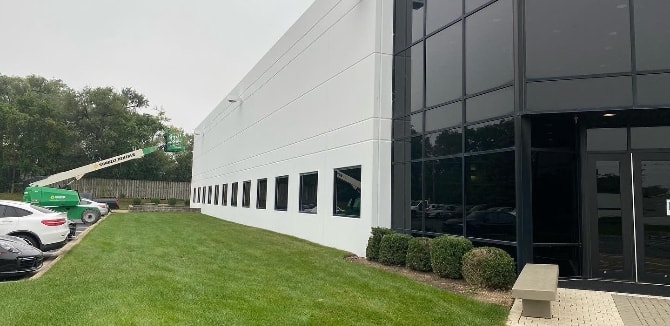
Old concrete will react differently than new concrete, so knowing the estimated age of the surface is important and something most painting contractors can determine. In any case, all concrete surfaces will be thoroughly cleaned, cracks will be filled and allowed to dry and only the best quality paints will be applied.
Concrete floor preparation for painting
Many commercial properties have concrete floors, many of which might have been covered with primer and paint or perhaps even tape used for directing traffic. In any case, removing old flooring materials is a big step in preparing concrete floors for paint. In order for the new paint or high-performing industrial floor system to adhere, all the previous materials must be removed. Imperfections will also be tended to following the removal of previous materials. This can include everything from cracks to holes.
Concrete walls preparation for painting
While flooring systems have their unique challenges, walls must also be cleaned and prepared for paint if the project is going to be a success. If the concrete has contracted and expanded over the years, cracks will most likely be present and must be filled before primer and/or paint can be applied. Quality contractor will ensure that all the debris following repairs is removed and the surface is completely dry before the first coat of paint is applied.
Concrete is just another surface type that all high-quality painting contractors know how to deal with prior to painting it. At Painters Inc., we have all the solutions necessary for making sure your concrete surfaces are thoroughly prepped.
How to prepare metal surfaces for painting
Metal is a common material in commercial buildings and it is important to properly prepare these surfaces prior to painting. Some types of metal are prone to rust, but applying paint can prevent this from occurring. To prepare metal for painting, contractors will clear any dirt or grime from the surface. It’s also common in the prep phase to remove peeling paint. If there is any rust buildup, that too must be removed or it will continue to get worse and new paint will fail to adhere. All metal burrs, dents or holes will also be removed/patched/repaired prior to painting. Without this thorough approach to preparation, even the highest quality paints will not be effective.
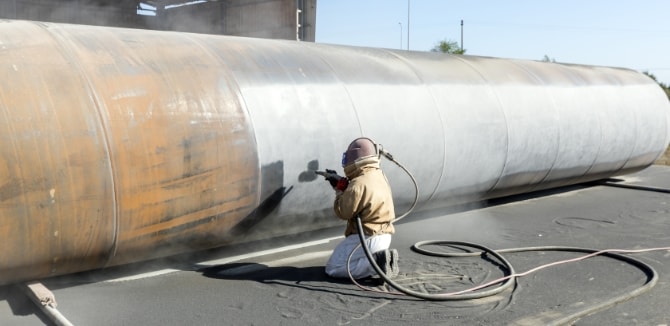
High-quality contractors will also know how to prep metal for spray paint. The above steps will most often be included when the surfaces are spray painted as opposed to being applied with a roller or brush. If the spray paint doesn’t include primer, most contractors will lay down a coat of primer prior to painting, and lightly sand it. This ensures proper adhesion of the paint.
How to prepare wood surfaces for painting
To prepare wood for painting, quality painting contractors know exactly what steps to take. Some property owners prefer a stain to accentuate the wood grain and get a rustic yet natural aesthetic. Wood is a substrate, so it can release moisture and sap and has other complexities, such as knots, all of which can pose problems when painting.
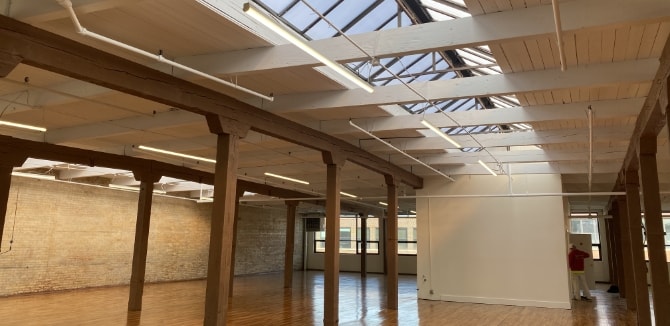
A contractor that knows how to prepare wood for painting will remove all imperfections, ensure it is dry, sap free and sanded before it is primed and/or painted. The wood must also be thoroughly cleaned, free of any kind of dirt or grime. In some cases, the best results will occur when the primer is sanded before the paint is applied. The first coat of paint might also be sanded for optimal results.
Choose the best commercial painter to prepare and paint your building
Painters Inc. is proud to be considered among the best commercial painters in the region. Our experience in painting commercial properties is extensive, which means we know how important it is to properly prepare surfaces before paint is applied. We couldn’t have established our reputation as a go-to painting contractor without having satisfactory outcomes, which always begin with plenty of preparation at the onset of a project.
We bring a team of experienced painters who know how to use cleaning equipment, from power washers to air blasters to vapor blasters. Our team also knows which medium works best on specific surface types. We can handle every step involved in surface preparation so that when we apply the industry-leading paints, they will look great and last a long time.
If your facility is looking a little haggard or if you’re simply ready for a new look with a new palette of colors, we will assist you. We’re licensed, certified and insured so you can rest assured that when you partner with Painters Inc., you’re getting a top-quality contractor that is dedicated to excellence. Contact us and let’s discuss your upcoming painting project.









